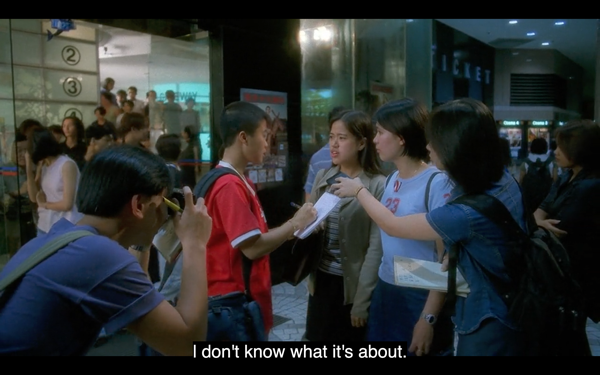

About HK filmmaking in the 90s.
edit: Es gibt aber natürlich auch wieder gute Nachrichten:
What the fuck?!
Wenn man sich die Kommentare durchliest, kommen die Likes von persönlichen Freunden, die dazu aufgefordert wurden. So funktioniert in Österreich auch Politik, und ja - genau, sie habens geahnt, geförderter Journalismus.
Ich glaub es braucht wieder mehr Qualitätsjournalisten Förderung. Für die letztklassige Musikuntermalung zum Beispiel. Oder für die ein Halbsatz Schnitte. Oder für das Melken eines Namedroppings in ner Fragestellung. Oder für die unprovozierte Wortwiderholung. Falsche grammatikalische Phrasierungen. Oder das Verwechseln von Kriegsführung mit hybrider Kriegsführung (hybride Kriegsführung sind nicht Drohnenangriffe, auch wenn sies im Beitrag so zeigen). Volle Verteidigungsfähigkeit unter der Tripwire-Doktrin? Anti-Nato Haltung in Österreich aufbauen? Fragen sie doch mal den Reisner, bezüglich des US Plans wie im Falle eines russischen Angriffs tatsächlich eine Verzögerungswirkung hergestellt werden sollte. *hust*
Gut dass ichs nicht offen ausspreche, oder wie?
Is schon artsy, wenn man sich in nen Panzer setzt oder? Mach ma das gleich in 5 verschiedenen shots…
AI Gebrabbel:
Operation Dropshot (1949):
As mentioned previously, Operation Dropshot was a U.S. contingency plan for a potential war with the Soviet Union in the 1950s. While its primary focus was strategic nuclear strikes on Soviet territory, it also considered tactical measures in Western Europe. This included the potential use of nuclear or conventional demolitions to destroy key infrastructure (e.g., bridges, rail lines, and ports) in NATO-controlled areas, particularly in West Germany, to slow Soviet advances. These actions were intended to create bottlenecks or delay Soviet logistics, even if it meant sacrificing Western assets.
Nuclear Demolitions: In extreme scenarios, Dropshot considered the use of low-yield atomic bombs or nuclear mines (e.g., Atomic Demolition Munitions, or ADMs, though these were not fully developed until the 1950s) to destroy infrastructure or create impassable barriers. For instance, nuclear explosions could render key transportation hubs radioactive or physically impassable, denying their use to Soviet forces.
Examples: Specific targets included the rail network in West Germany, which was vital for moving troops and supplies, and ports like Hamburg or Bremerhaven, which could be used by the Soviets if captured. The plan prioritized assets that, if left intact, would enable rapid Soviet advances.
Retardation Operations:
Dropshot emphasized “retardation” or “delaying” operations, which aimed to disrupt Soviet logistics and command structures in Western Europe. These operations involved:
Air Strikes: U.S. and allied air forces, including nuclear-capable bombers like the B-29 and later B-36, would target Soviet troop concentrations, supply depots, and forward command posts in NATO territory. These strikes could involve conventional bombs or, in extreme cases, tactical nuclear weapons.
Ground Operations: NATO ground forces, including U.S. and West German units, would conduct defensive operations to hold key terrain while preparing to destroy infrastructure as they retreated. This was part of a broader “defense in depth” strategy to slow Soviet momentum.
The goal was to create choke points and delay Soviet forces long enough for NATO to mobilize reinforcements, particularly from the U.S. via air and sea (a precursor to later REFORGER concepts).
Tactical Nuclear Weapons:
Although tactical nuclear weapons were not widely available in 1949, Dropshot anticipated their development and deployment by the mid-1950s. The plan envisioned using low-yield atomic bombs (1–20 kilotons) to target Soviet forces advancing through Western Europe. These strikes could occur in West Germany or other NATO countries if Soviet forces crossed the border.
Specific targets included Soviet armored divisions, supply convoys, and airfields captured by the Soviets in Western zones. For example, a nuclear strike on a Soviet tank column in the Fulda Gap could disrupt an entire offensive, though it would also devastate the surrounding area.
Dropshot’s planners recognized that nuclear strikes in Western zones would cause significant collateral damage, including civilian casualties and destruction of allied infrastructure, but deemed this acceptable in the face of a Soviet occupation.
Ich glaub ich tret heut noch dem österreichischen Militär bei, damit es sich in dieser Form besser verteidigen kann, und niemand gegen die Nato Stimmung macht.
Scheiss auf die Österreichische Verfassung, nicht?
MC 48 and “New Look” Policy (1954):
Overview: The NATO strategy document MC 48, adopted in 1954, formalized the use of tactical nuclear weapons to stop a Soviet invasion in Western Europe. This aligned with the U.S.’s “New Look” policy under President Eisenhower, which emphasized nuclear weapons to offset conventional weaknesses.
Implementation: NATO deployed nuclear-capable systems like the MGR-1 Honest John rocket, M29 Davy Crockett recoilless rifle, and MGM-5 Corporal missile to West Germany. These weapons, with yields from 0.01 to 20 kilotons, were intended for battlefield use against Soviet troop concentrations, supply lines, or infrastructure in NATO territory if overrun.
Western Zones: Plans included nuclear strikes on advancing Soviet forces in West Germany, particularly in chokepoints like the Fulda Gap or North German Plain. For example, NATO’s “Carte Blanche” exercise (1955) simulated 268 nuclear strikes, many in West Germany, to halt a Soviet offensive, assuming significant destruction of allied infrastructure and civilian areas.
Rationale Continuity: Like Dropshot, these plans aimed to disrupt Soviet logistics and mobility, even at the cost of Western assets. However, the focus shifted from preemptive demolitions to battlefield nuclear strikes targeting enemy forces directly.
3. Flexible Response Doctrine (1967–1980s)
By the mid-1960s, NATO adopted the “flexible response” doctrine (MC 14/3, 1967), which shifted away from reliance on massive nuclear retaliation to a graduated approach, balancing conventional and nuclear options.Overview: Flexible response aimed to deter Soviet aggression with conventional forces first, escalating to tactical nuclear weapons only if necessary. This doctrine still included plans to target Western zones to disrupt Soviet advances, but with greater emphasis on precision and minimizing allied losses.
Implementation:
Conventional Delaying Actions: NATO’s forward defense strategy involved holding key terrain in West Germany with mechanized units (e.g., U.S. VII Corps, German I Corps). If forced to retreat, units would destroy infrastructure to slow Soviet pursuit, similar to Dropshot’s retardation operations.
Tactical Nuclear Options: NATO maintained plans to use nuclear artillery (e.g., M109 howitzers with W48 nuclear shells) or air-delivered bombs (e.g., B61 bombs) against Soviet forces in Western zones. Exercises like “Able Archer” (1983) simulated such scenarios, with nuclear strikes in West Germany to halt a Soviet breakthrough.
Fuck me - wenn wir erst die ganzen Anti-Informations Kriegsführungs Kämpfer beim österreichischen Bundesheer anstellen, die das unter den Teppich kehren, …
Ich mein, jo scheisse - wie schaut denn das aus?
Key Differences from Dropshot
While these newer plans carried forward Dropshot’s rationale, they differed in several ways:Reduced Nuclear Emphasis: As NATO’s conventional forces improved (e.g., M1 Abrams tanks, F-15 fighters), reliance on nuclear demolitions decreased. Flexible response and AirLand Battle prioritized conventional delaying tactics.
Precision and Technology: Advances in precision-guided munitions and intelligence (e.g., satellite reconnaissance) allowed more targeted denial operations, reducing the need for widespread destruction of Western zones.
Political Sensitivity: West Germany’s integration into NATO and its economic importance led to greater caution about plans that would devastate allied territory. Public and political opposition to nuclear use grew, especially in the 1970s–1980s.
DANKE AI, für deine Offenheit…
Challenges and Controversies
Collateral Damage: Plans to destroy infrastructure or use nuclear weapons in West Germany remained controversial, as they would devastate civilian areas and economies. For example, NATO’s 1970s war games estimated millions of civilian casualties from tactical nuclear use
Aber zumindest nicht russisch, sag ich mir immer.
Btw. kein Experte, ich hab nur Reisner darüber reden gehört, und dann ne AI beansprucht. Aber ja, so sah die “Verteidigungsfähigkeit Österreichs” unter Tripwire mal aus.
Unseren Alpbach Experten kanns garnicht schnell genug gehen, dahin wieder zurück zu wollen.

